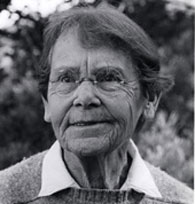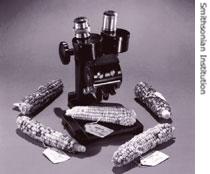-
(单词翻译:双击或拖选)
PEOPLE IN AMERICA - Barbara McClintock, 1902-1992: She Made Important Discoveries About Genes1 and Chromosomes3
She was the first American woman to win an unshared Nobel Prize. Transcript4 of radio broadcast:
03 May 2008
VOICE ONE:
I’m Doug Johnson.
VOICE TWO:
And I’m Barbara Klein with PEOPLE IN AMERICA in VOA Special English. Today, we tell about Barbara McClintock. She was one of the most important scientists of the twentieth century. She made important discoveries about genes and chromosomes.
(MUSIC)
VOICE ONE:
 |
| Barbara McClintock |
Barbara McClintock was born in nineteen-oh-two in Hartford, Connecticut. Barbara was the third of four children. Her family moved to the Brooklyn area of New York City in nineteen-oh-eight. Barbara was an active child with interests in sports and music. She also developed an interest in science.
She studied science at Cornell University in Ithaca, New York. Barbara was among a small number of undergraduate students to receive training in genetics in nineteen twenty-one. Years later, she noted6 that few college students wanted to study genetics.
VOICE TWO:
In the early nineteen twenties, genetics had not received widespread acceptance as a subject. Only twenty years had passed since scientists rediscovered the theories of heredity. Gregor Mendel proposed these ideas after completing a series of experiments with plants. His experiments helped scientists better understand how genes operate. They showed how genetic5 qualities are passed to living things from their ancestors.
VOICE ONE:
Barbara McClintock decided7 to study botany, the scientific study of plants, at Cornell University. She completed her undergraduate studies in nineteen twenty-three. McClintock decided to continue her education at Cornell. She completed a master’s degree in nineteen twenty-five. Two years later, she finished all her requirements for a doctorate8 degree.
In the late nineteen twenties, McClintock joined several other students in a group that studied genetics. The students included a future winner of the Nobel Prize, George Beadle. Another was Marcus Rhoades. Years later, he would become a leading expert in genetics.
McClintock said both men recognized the importance of exploring the connection between genes and chromosomes.
McClintock stayed at Cornell after she completed her education. She taught students botany. She also supervised genetic studies of the corn plant, or maize9. She studied chromosomes, which are lines of genes. She made several discoveries about genes and chromosomes.
VOICE TWO:
The nineteen thirties were not a good time to be a young scientist in the United States. The country was in the middle of the great economic Depression. Millions of Americans were unemployed10. Male scientists were offered jobs. But female geneticists were not much in demand.
McClintock received two offers to travel and carry out research projects. The first came from America’s National Research Council. She worked at several places, including Cornell and the University of Missouri in Columbia. Later, a group called the Guggenheim Foundation provided financial aid for her to study in Germany. McClintock went to Berlin, but returned to Cornell the following year. Her skills and work were widely praised. But she still was unable to find a permanent job.
(MUSIC)
VOICE ONE:
For years, scientists had been using x-rays to study genetic material in plants and other organisms. They found that x-rays caused genes to change. Sometimes, the x-rays physically11 broke the chromosome2. Genetic researchers looked for changes in the organism. Then they used this information to produce a map linking the changes to a single area of the chromosome.
McClintock became interested in the way genes reacted to unusual events. She formed a successful working relationship with Lewis Stadler of the University of Missouri. He had demonstrated the effects of x-rays on corn.
Stadler sent maize treated with radiation to McClintock. She identified unusual areas she called ring chromosomes. She believed they were chromosomes broken by radiation. The broken ends sometimes joined together and formed a circle, or ring. This led her to believe that a structure at the end of the chromosome prevents chromosomes from changing. She called this structure the telomere.
VOICE TWO:
Stadler got the University of Missouri to offer a permanent position to McClintock in nineteen thirty-six. She became an assistant professor. During her time at the university, she worked with plants treated with x-rays. She also discovered plants with chromosomes that broke without help of radiation. She described this activity as the breakage-fusion-bridge cycle.
University officials and professors recognized the importance of McClintock’s research. Yet she believed that she was not able to make progress in her position. So she decided to leave the University of Missouri.
(MUSIC)
VOICE ONE:
An old friend from Cornell, Marcus Rhoades, invited McClintock to spend the summer of nineteen forty-one working at the Cold Spring Harbor Laboratory. It is a research center on Long Island, near New York City.
McClintock started in a temporary job with the genetics department. A short time later, she accepted a permanent position with the laboratory. This gave her the freedom to continue her research without having to teach or repeatedly ask for financial aid.
At Cold Spring Harbor Laboratory, McClintock continued her work with the breakage-fusion-bridge cycle. She found that some corn plant genes acted in an unusual way. They appeared to move from cell to cell during development of corn particles, or kernels12. She discovered that the genes moved on and between chromosomes.
VOICE TWO:
McClintock confirmed her discovery and extended her observations for six years. The changes could not be explained by any known theory. So, she developed her own theory. She believed the moveable genes were not genes at all, but genetic controllers or controlling elements. She said they influenced the actions of other genes.
During this period, McClintock was elected to the National Academy of Sciences. She was the third woman ever so honored. She also was named president of the Genetics Society of America.
VOICE ONE:
In nineteen fifty-one, McClintock was asked to present her findings at a conference held at Cold Spring Harbor Laboratory. Her report described the movement of genes from one part of a chromosome to another. She used the presentation to discuss her ideas of controlling elements in genes.
The other scientists reacted to her ideas with a mixture of criticism and silence. Most scientists believed that genes did not move. Few people seemed to accept her findings. Yet others argued that her experiments were complex and difficult to explain, even to other scientists. They said she would not have been invited to speak unless conference organizers understood some of the importance of her work.
(MUSIC)
VOICE TWO:
 |
| Barbara McClintock's microscope and five ears of corn at the National Museum of American History |
For years, many scientists dismissed McClintock’s findings. During this period, she continued doing her own work and reaching her own findings. Beginning in the late nineteen fifties, she went to Central and South America to study different kinds of maize plants. She examined the development of agricultural maize by native peoples. She also assisted younger scientists and students in genetics.
Her work at the Cold Spring Harbor Laboratory was recognized in nineteen seventy. She was given the American government’s highest science award – the National Medal of Science.
VOICE ONE:
By the nineteen seventies, newly developed methods of molecular13 biology confirmed what McClintock had learned through observation. Her discoveries have had an effect on everything from genetic engineering to cancer research.
McClintock won the Nobel Prize for Physiology14 or Medicine in nineteen eighty-three for her discovery of the ability of genes to change positions on chromosomes. She was the first American woman to win an unshared Nobel Prize.
Barbara McClintock remained at Cold Spring Harbor for the rest of her life. She died in nineteen ninety-two. She was ninety years old.
(MUSIC)
VOICE TWO:
This program was written by George Grow. Lawan Davis was our producer. I’m Barbara Klein.
VOICE ONE:
And I’m Doug Johnson. Join us again next week for PEOPLE IN AMERICA in VOA Special English.
 收听单词发音
收听单词发音
1
genes

|
|
| n.基因( gene的名词复数 ) | |
参考例句: |
|
|
|
2
chromosome

|
|
| n.染色体 | |
参考例句: |
|
|
|
3
chromosomes

|
|
| n.染色体( chromosome的名词复数 ) | |
参考例句: |
|
|
|
4
transcript

|
|
| n.抄本,誊本,副本,肄业证书 | |
参考例句: |
|
|
|
5
genetic

|
|
| adj.遗传的,遗传学的 | |
参考例句: |
|
|
|
6
noted

|
|
| adj.著名的,知名的 | |
参考例句: |
|
|
|
7
decided

|
|
| adj.决定了的,坚决的;明显的,明确的 | |
参考例句: |
|
|
|
8
doctorate

|
|
| n.(大学授予的)博士学位 | |
参考例句: |
|
|
|
9
maize

|
|
| n.玉米 | |
参考例句: |
|
|
|
10
unemployed

|
|
| adj.失业的,没有工作的;未动用的,闲置的 | |
参考例句: |
|
|
|
11
physically

|
|
| adj.物质上,体格上,身体上,按自然规律 | |
参考例句: |
|
|
|
12
kernels

|
|
| 谷粒( kernel的名词复数 ); 仁; 核; 要点 | |
参考例句: |
|
|
|
13
molecular

|
|
| adj.分子的;克分子的 | |
参考例句: |
|
|
|
14
physiology

|
|
| n.生理学,生理机能 | |
参考例句: |
|
|
|















